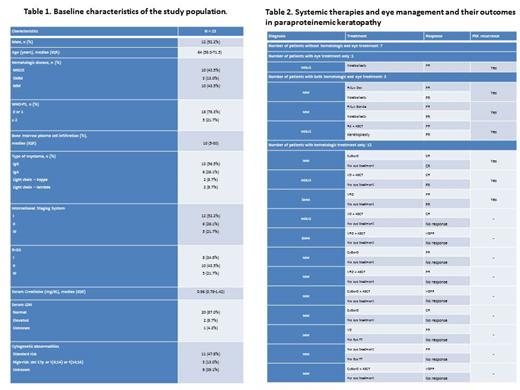Abstract
Introduction
Monoclonal gammopathy of ocular significance (MGOS) is a rare subset of monoclonal gammopathy of clinical significance (MGCS) occurring secondary to plasma cell dyscrasia resulting in ocular manifestations. Given the rarity of these conditions, optimal management strategies are not defined; the approach is dependent upon the underlying cause of the monoclonal gammopathy and whether or not the patient's vision is affected. We report our review of 23 cases with MGOS, more specifically on paraproteinemic keratopathy (PPK) the most common form, to obtain a better understanding of the patient characteristics, diagnosis and treatments.
Methods
We report an international retrospective series of patients with MGOS. Data was collected on patients with MGOS:there were no other inclusion criteria besides monoclonal gammopathy with an ophthalmologic manifestation; however, this report focuses only on patients with PPK. Efficacy outcomes were the hematologic and the ocular responses in patients with PPK. Hematologic responses were reported according to the IMWG response criteria. The ophthalmologic response to treatment was assessed by each contributing physician and reported as either complete, partial or no sight recovery.
Results
We identified 23 patients with PPK in the setting of monoclonal gammopathy of unknown significance (MGUS), smoldering multiple myeloma (SMM), or multiple myeloma (MM) diagnosed between 2006 and 2019 in 7 countries. Table 1 summarizes the patients' characteristics. The ocular diagnosis was typically made at the same time or after the hematologic diagnosis. Eleven of 23 patients presented decreased vision. Four were treated by penetrating keratoplasty with or without systemic therapy, including chemotherapy with new generation anti-MM agents with or without autologous stem cell transplantation (ASCT). All patients with MM and 40% of those with other diagnoses such as SMM or MGUS received systemic therapy. In most cases, neither ocular nor hematologic treatment, even when ASCT was performed, afforded a durable improvement in the visual acuity despite initial responses. MGOS typically relapsed within one year of the initial response (Table 2).
Conclusion
To date, this is the largest retrospective study focusing on MGOS patients with monoclonal immunoglobulin deposits accumulating in the cornea and resulting in visual impairment. Further studies will be required to determine the optimal strategy to treat and prevent the relapse of ocular symptoms in patients with PPK and specifically to address the timing of keratoplasty and systemic chemotherapy and the role of maintenance therapy. Patients with corneal manifestation of unknown origin should undergo a hematologic check-up and patients with paraproteinemia should have a periodic ocular health assessment.
Garderet: Takeda: Consultancy; Sanofi: Consultancy; Amgen: Consultancy; Janssen: Consultancy; Celgene: Consultancy. Munder: Janssen: Consultancy, Honoraria; BMS: Consultancy, Honoraria; Abbvie: Consultancy; Takeda: Consultancy, Honoraria; Amgen: Honoraria; Sanofi: Consultancy; GSK: Consultancy; Incyte: Research Funding. Gozzetti: AbbVie: Honoraria; Janssen: Honoraria. Rosinol: Janssen, Celgene, Amgen and Takeda: Honoraria. Jurczyszyn: Janssen-Cilag, Amgen: Honoraria, Speakers Bureau.


This feature is available to Subscribers Only
Sign In or Create an Account Close Modal